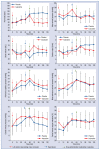Ivabradine in acute heart failure: Effects on heart rate and hemodynamic parameters in a randomized and controlled swine trial
- PMID: 30155868
- PMCID: PMC8086495
- DOI: 10.5603/CJ.a2018.0078
Ivabradine in acute heart failure: Effects on heart rate and hemodynamic parameters in a randomized and controlled swine trial
Abstract
Background: Acute heart failure patients could benefit from heart rate reduction, as myocardial consumption and oxidative stress are related to tachycardia. Ivabradine could have a clinical role attenuating catecholamine-induced tachycardia. The aim of this study was to evaluate hemodynamic effects of ivabradine in a swine model of acute heart failure.
Methods: Myocardial infarction was induced by 45 min left anterior descending artery balloon occlusion in 18 anesthetized pigs. An infusion of dobutamine and noradrenaline was maintained aiming to preserve adequate hemodynamic support, accompanied by fluid administration to obtain a pulmonary wedged pressure ≥ 18 mmHg. After reperfusion, rhythm and hemodynamic stabilization, the animals were randomized to 0.3 mg/kg ivabradine intravenously (n = 9) or placebo (n = 9). Hemodynamic parameters were observed over a 60 min period.
Results: Ivabradine was associated with a significant reduction in heart rate (88.4 ± 12.0 bpm vs. 122.7 ± 17.3 bpm after 15 min of ivabradine/placebo infusion, p < 0.01) and an increase in stroke volume (68.8 ± 13.7 mL vs. 52.4 ± 11.5 mL after 15 min, p = 0.01). There were no significant differences in systemic or pulmonary arterial pressure, or significant changes in pulmonary capillary pressure. However, after 15 min, cardiac output was significantly reduced with ivabradine (-5.2% vs. +15.0% variation in ivabradine/placebo group, p = 0.03), and central venous pressure increased (+4.2% vs. -19.7% variation, p < 0.01).
Conclusions: Ivabradine reduces heart rate and increases stroke volume without modifying systemic or left filling pressures in a swine model of acute heart failure. However, an excessive heart rate reduction could lead to a decrease in cardiac output and an increase in right filling pressures. Future studies with specific heart rate targets are needed.
Keywords: acute heart failure; heart rate; ivabradine; porcine model; swine model.
Conflict of interest statement
Figures


Similar articles
-
Long-term heart rate reduction induced by the selective I(f) current inhibitor ivabradine improves left ventricular function and intrinsic myocardial structure in congestive heart failure.Circulation. 2004 Apr 6;109(13):1674-9. doi: 10.1161/01.CIR.0000118464.48959.1C. Epub 2004 Feb 23. Circulation. 2004. PMID: 14981003
-
Reversing dobutamine-induced tachycardia using ivabradine increases stroke volume with neutral effect on cardiac energetics in left ventricular post-ischaemia dysfunction.Acta Physiol (Oxf). 2016 Oct;218(2):78-88. doi: 10.1111/apha.12704. Epub 2016 May 24. Acta Physiol (Oxf). 2016. PMID: 27145482
-
Initiation of ivabradine in cardiogenic shock.ESC Heart Fail. 2019 Oct;6(5):1088-1091. doi: 10.1002/ehf2.12499. Epub 2019 Jul 23. ESC Heart Fail. 2019. PMID: 31332966 Free PMC article.
-
The role of heart rate and ivabradine in acute heart failure.Monaldi Arch Chest Dis. 2019 Oct 7;89(3). doi: 10.4081/monaldi.2019.1091. Monaldi Arch Chest Dis. 2019. PMID: 31594282 Review.
-
Hemodynamic effects of ivabradine use in combination with intravenous inotropic therapy in advanced heart failure.Heart Fail Rev. 2021 Mar;26(2):355-361. doi: 10.1007/s10741-020-10029-x. Epub 2020 Sep 30. Heart Fail Rev. 2021. PMID: 32997214 Review.
Cited by
-
Relationship between Noise Exposure and Prognosis of Patients with Heart Failure: A Retrospective Analysis.Noise Health. 2024 Jan-Mar 01;26(120):51-57. doi: 10.4103/nah.nah_101_23. Epub 2024 Mar 23. Noise Health. 2024. PMID: 38570311 Free PMC article.
-
Ivabradine-Stimulated Microvesicle Release Induces Cardiac Protection against Acute Myocardial Infarction.Int J Mol Sci. 2020 Sep 8;21(18):6566. doi: 10.3390/ijms21186566. Int J Mol Sci. 2020. PMID: 32911752 Free PMC article.
-
Ivabradine effects in hospitalized acute heart failure patients: a single center retrospective study.Am J Cardiovasc Dis. 2023 Jun 25;13(3):177-182. eCollection 2023. Am J Cardiovasc Dis. 2023. PMID: 37469535 Free PMC article.
-
Ivabradine Induces Cardiac Protection against Myocardial Infarction by Preventing Cyclophilin-A Secretion in Pigs under Coronary Ischemia/Reperfusion.Int J Mol Sci. 2021 Mar 12;22(6):2902. doi: 10.3390/ijms22062902. Int J Mol Sci. 2021. PMID: 33809359 Free PMC article.
-
Effects of ivabradine on the prevention of intradialytic hypotension in a dialytic patient with heart failure with reduced ejection fraction.BMJ Case Rep. 2021 Nov 30;14(11):e246011. doi: 10.1136/bcr-2021-246011. BMJ Case Rep. 2021. PMID: 34848415 Free PMC article.
References
-
- Ponikowski P, Voors AA, Anker SD, et al. 2016 ESC Guidelines for the diagnosis and treatment of acute and chronic heart failure: The Task Force for the diagnosis and treatment of acute and chronic heart failure of the European Society of Cardiology (ESC). Developed with the special contribution of the Heart Failure Association (HFA) of the ESC. Eur J Heart Fail. 2016;18(8):891–975. doi: 10.1002/ejhf.592. - DOI - PubMed
-
- Hastillo A, Taylor DO, Hess ML. Secific ositiv inotroic agents. In: Messerli FH, editor. Cardiovascular drug theray. 2nd Ed. W G Saunders Company; Philadelphia: 1996. pp. 1151–1161.
-
- Tisdale JE, Patel R, Webb CR, et al. Electrophysiologic and proarrhythmic effects of intravenous inotropic agents. Prog Cardiovasc Dis. 1995;38(2):167–180. - PubMed
MeSH terms
Substances
LinkOut - more resources
Full Text Sources
Other Literature Sources
Medical
